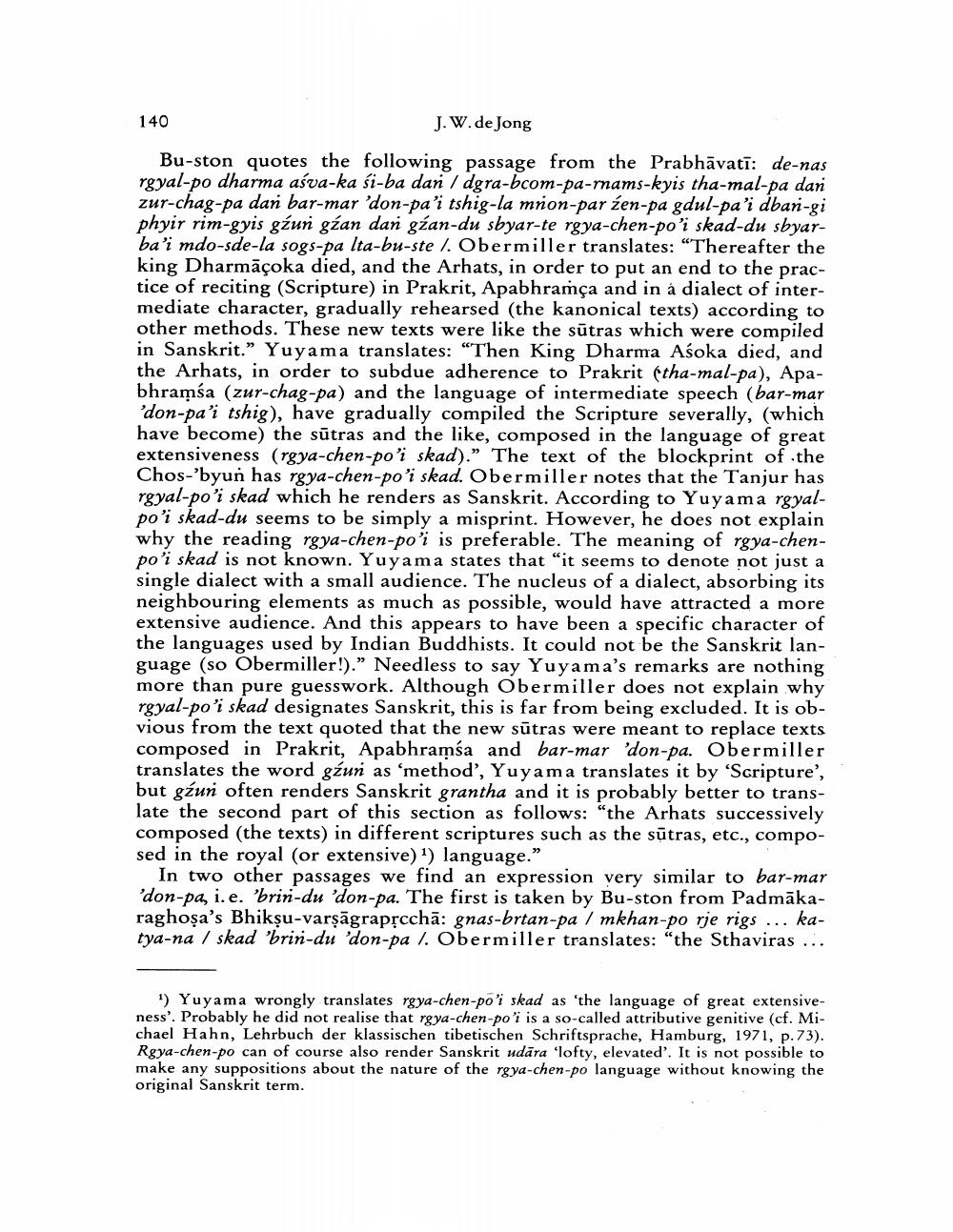________________
J. W. de Jong
Bu-ston quotes the following passage from the Prabhāvatī: de-nas rgyal-po dharma aśva-ka si-ba dan / dgra-bcom-pa-rnams-kyis tha-mal-pa dan zur-chag-pa dań bar-mar 'don-pa'i tshig-la mnon-par źen-pa gdul-pa'i dban-gi phyir rim-gyis gźun gźan dan gźan-du sbyar-te rgya-chen-po'i skad-du sbyarba'i mdo-sde-la sogs-pa Ita-bu-ste / Obermiller translates: "Thereafter the king Dharmāçoka died, and the Arhats, in order to put an end to the prac tice of reciting (Scripture) in Prakrit, Apabhramça and in a dialect of intermediate character, gradually rehearsed (the kanonical texts) according to other methods. These new texts were like the sutras which were compiled in Sanskrit." Yuyama translates: "Then King Dharma Aśoka died, and the Arhats, in order to subdue adherence to Prakrit (tha-mal-pa), Apabhramsa (zur-chag-pa) and the language of intermediate speech (bar-mar 'don-pa'i tshig), have gradually compiled the Scripture severally, (which have become) the sütras and the like, composed in the language of great extensiveness (rgya-chen-po'i skad)." The text of the blockprint of the Chos-'byun has rgya-chen-po'i skad. Obermiller notes that the Tanjur has rgyal-po'i skad which he renders as Sanskrit. According to Yuyama rgyalpo'i skad-du seems to be simply a misprint. However, he does not explain why the reading rgya-chen-po'i is preferable. The meaning of rgya-chenpo'i skad is not known. Yuyama states that "it seems to denote not just a single dialect with a small audience. The nucleus of a dialect, absorbing its neighbouring elements as much as possible, would have attracted a more extensive audience. And this appears to have been a specific character of the languages used by Indian Buddhists. It could not be the Sanskrit language (so Obermiller!)." Needless to say Yuyama's remarks are nothing more than pure guesswork. Although Obermiller does not explain why rgyal-po'i skad designates Sanskrit, this is far from being excluded. It is obvious from the text quoted that the new sutras were meant to replace texts composed in Prakrit, Apabhramsa and bar-mar 'don-pa. Obermiller translates the word gźun as 'method', Yuyama translates it by 'Scripture', but gźur often renders Sanskrit grantha and it is probably better to translate the second part of this section as follows: "the Arhats successively composed (the texts) in different scriptures such as the sutras, etc., composed in the royal (or extensive) 1) language."
140
In two other passages we find an expression very similar to bar-mar 'don-pa, i. e. "brin-du 'don-pa. The first is taken by Bu-ston from Padmakaraghosa's Bhiksu-varṣāgrapṛcchä: gnas-brtan-pa / mkhan-po rje rigs... katya-na / skad 'brin-du 'don-pa /. Obermiller translates: "the Sthaviras...
1) Yuyama wrongly translates rgya-chen-po'i skad as 'the language of great extensiveness'. Probably he did not realise that rgya-chen-po'i is a so-called attributive genitive (cf. Michael Hahn, Lehrbuch der klassischen tibetischen Schriftsprache, Hamburg, 1971, p.73). Rgya-chen-po can of course also render Sanskrit udara 'lofty, elevated'. It is not possible to make any suppositions about the nature of the rgya-chen-po language without knowing the original Sanskrit term.




